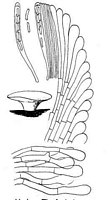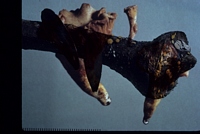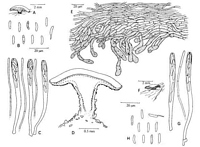|
 Lanzia allantospora Lanzia allantospora
SynonymsHelotium allantosporum
BiostatusPresent in region - Indigenous. Endemic
Images (click to enlarge)
Caption: FIG. 16 Helotium allantosporum. Habit sketch x 10, details x 660. | 
Caption: Lanzia allantospora, apothecia on fallen kauri twigs
Owner: Herb PDD | 
Caption: Figure 59. Lanzia allantospora. A-E. Holotype. A. Apothecium. B. Ascospores. C. Asci
and paraphyses. D. Vertical section. E. Ectal excipulum on receptacle. F-H. Bell 115. F. Apothecia. G. Asci and paraphysis. H. Ascospores. |
Article: Spooner, B.M. (1987). Helotiales of Australasia: Geoglossaceae, Orbiliaceae, Sclerotiniaceae, Hyaloscyphaceae. Bibliotheca Mycologica 116: 711 p.
Description: STROMA substratal, forming black lines within the substrate and irregular surface blackening.
APOTHECIA gregarious to scattered, superficial or erumpent through bark, shortly stipitate
to subsessile. DISC 1-3 mm diam., convex or plane, dark brown, olivaceous or blackish when
dry, with a somewhat inrolled margin, rehydrating pale orange-brown, or yellowish-olivaceous, smooth. RECEPTACLE cupulate to saucer-shaped, brown or with olive tinge,
the surface conspicuously scurfy when dry, less so when rehydrated. STIPE central, short,
stout, cylindrical, darker towards the base, otherwise concolorous, scurfy. ASCI 8-spored,
narrowly cylindric-clavate, tapered below to a narrow base, often enlarged to a small foot 2.5-3.5 µm diam., apex rounded or somewhat flattened, the pore faintly blued by Melzer's reagent,
(70-)75-90 x 5-7 µm. ASCOSPORES hyaline, cylindric, frequently curved or allantoid, ends
rounded, non-septate, usually containing 2 small guttules biseriate or irregularly arranged, 8-10 x 1.5-2.0, mean 8.8 (SD 0.7) x mean 1.8 (SD 0.1 µm (holotype); 8.5-12.5 x 1.5-2.0, mean
9.8 (SD 0.8) x mean 1.6 (SD 0.1) µm (P.D.D. 19412). PARAPHYSES simple, filiform,
obtuse, remotely septate, equal to the asci, 1.0-1.5 µm diam., enlarged slightly to 2 µm at the
apex. SUBHYMENIUM usually distinct, 50-60 µm deep, composed of closely interwoven
pale brown hyphae 2-3 µm diam. MEDULLARY EXCIPULUM composed of loosely
interwoven hyphae 2-4 µm diam., subhyaline to pale brown in the receptacle and upper stipe,
becoming more deeply pigmented towards the stipe base, the pigment irregularly deposited
and often giving a granular appearance to the walls. ECTAL EXCIPULUM distinctly
delimited, duplex in the stipe, there comprising an innermost layer 15-20 µm thick of vertically
oriented dark-brown, septate hyphae 2-3 µm diam., the pigment forming irregular granules on
the walls. This layer disappears towards the stipe apex. Outermost layer 20-35 µm thick,
present in the receptacle, narrowed to the margin, composed of parallel, hyaline or faintly
pigmented hyphae septate to produce elongated cells 15-25 x 3-4 µm, arranged at a low angle
to the surface and there giving rise to free, hair-like structures. These structures are thin-walled, 0-2-septate pale brown on the receptacle, more deeply pigmented towards the stipe
base, the pigmentation often granular, variable in length, up to about 80 µm long, somewhat
clavate obtuse, 6-10 µm diam., adpressed to the surface or spreading and entangled, less
evident towards the margin.
Habitat: On bark of frondose tree and on Agathis australis
(Araucariaceae). Auckland, New Zealand.
Notes: This species is known from two collections, both of which show some surface blackening of
the substrate, though not in association with all apothecia, and, in addition, more or less
conspicuous black stromatic lines beneath the surface. The irregular granular deposition of
pigment in the excipular hyphae is characteristic of many species of Lanzia, and there is no
doubt that the species is correctly placed here. Dennis (1961, 1964) suggested for this species
an affinity with Chlorosplenium. He compared the surface hairs to those of C. versiforme, but
excluded the species from Chlorosplenium because of the lack of green tints in the apothecia.
However, Dixon (1975) established the genus Chlorencoelia, typified by C. versiforme, and
showed the structure of this species to be akin to that of Encoelia, having an ectal excipulum
composed of angular cells quite unlike that of H. allantosporum.
The surface hairs of the present species are longer and more distinct than in many species
of Lanzia, and the spores also provide diagnostic characters. I am not aware of any other
species referred either to Lanzia or Rutstroemia, which have spores of a similar shape.
Article: Dennis, R.W.G. (1961). Some inoperculate Discomycetes from New Zealand. Kew Bulletin 15(2): 293-320.
Notes: Flesh dark brown throughout, composed of loosely woven purplish-brown hyphae 3-4 µ wide;
excipulum composed of parallel, brown, thin-walled hyphae lying at a low angle to the surface,
their tips running out into 1-2celled cylindrical hairs, with the tip cell inflated to 8-10 µ
diameter. These hairs recall those of Chlorosplenium versiforme but the fungus completely
lacks green or olive tints and can scarcely be referred to that genus.
|